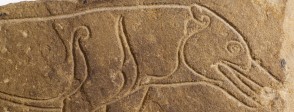Start off the students’ enquiries by focusing on the wolf and the stones themselves.
Show students the picture of the Ardross Wolf in For the classroom. Give them the dimensions of the stone and ask them to work out what animal it is and what kind of object it was on. Do they think the object is complete? If not, why not? Explain that it was part of a larger stone. Ask them to list possible reasons for putting up a carved stone. Show them some photos of actual stones in the landscape. Possibilities might be as a grave marker, a boundary marker or to commemorate an event. What other ideas do they have? What do they prefer and why?
Show students the image of the Ardross deer’s head in For the classroom. Some archaeologists think that this was part of the same stone as the wolf, which might also have had geometric designs on like the Strathmartine stone in For the classroom. Look at some of the symbols in the Historic Scotland Teacher Resources in More information. Ask students to draw the full stone as they think it would have looked. Use the 3D rotating scans of later standing stones in For the classroom to compare with their reconstruction drawing. What are the similarities and differences? All these standing stones are later than the one at Ardross. What symbols are on them that weren’t on the Ardross stone? A simple internet search for Class II Pictish stones will generate many examples of stones with Christian symbols.
Print out images of the objects in A bigger picture. Ask students to sort the pictures into the following categories: animals that are eaten; pets; animals that are feared; fantasy animals; guardian animals; good luck charms. Think of lots more and categorise them. Do they think any animals fit into more than one category? Which category do they think the Ardross Wolf falls into?
The next two teaching ideas use the BBC Class Clips video about Pictish symbol stones in For the classroom.
What reasons does the video suggest for why the Picts carved animals on the stones? What does the stone-carver Andy think might be the reason why the two animals are on the same stone? What do students think the Pictish beastie was? What about the non-animal symbols like the crescent, v-shape and the others: what do they think they might have meant?
Watch the video again. Early Pictish symbol stones had incised images that were carefully pecked out with hammer and chisel - see how Andy does it. Later symbol stones were carved in relief, meaning that 3D animals and shapes were brought out by cutting back the background. Try to identify whether each stone shown on the video is incised or in relief. Compare the Burghead bull in For the classroom. Get students to try making the two different types of symbol stone by carving in chalk or soap or air-hardened clay.
There is evidence of book-making at the monastery of Portmahomack, suggesting that the symbol stones could be the only survivors of an artistic style that was also applied in other media, like leather, metal and wood. Some archaeologists believe that the art of the Picts inspired the animal art that flourished in the illuminated gospels of the later 7th and 8th centuries. Find out more about these early medieval gospels and compare them with the symbol stones. What do students find similar and what different?
Here are two enquiries that can spring from the Ardross wolf.
What was everyday life for a Pict?
We can tell that there must have been Pictish stone carvers. Use the links in For the classroom to help the students find out about other sorts of work. What other jobs must there have been? What did people wear? What did they eat? What were their houses like? How did they travel? What are our sources of evidence? Are there aspects of Pictish life they would like to know about, but do not have evidence for?
How and why do cultures change?
The change of imagery from pagan to Christian on the Pictish stones offers a nice clear example of religion influencing art. Using this as a starting point, explore other cases from history where religion has changed and this has influenced a culture’s art. Go on to look at examples of change caused by something other than religion.


